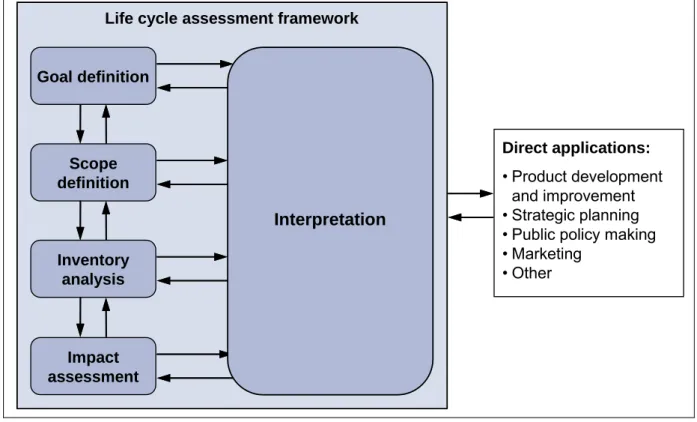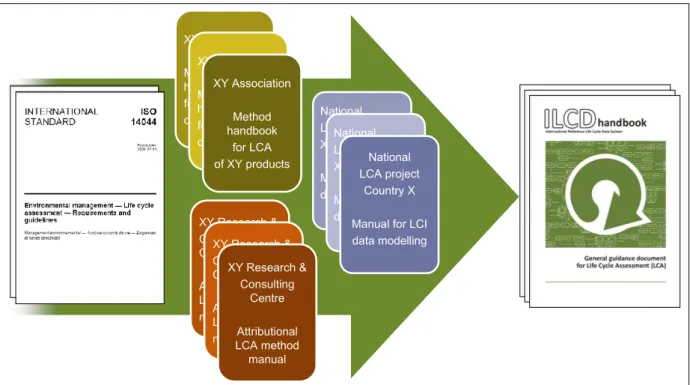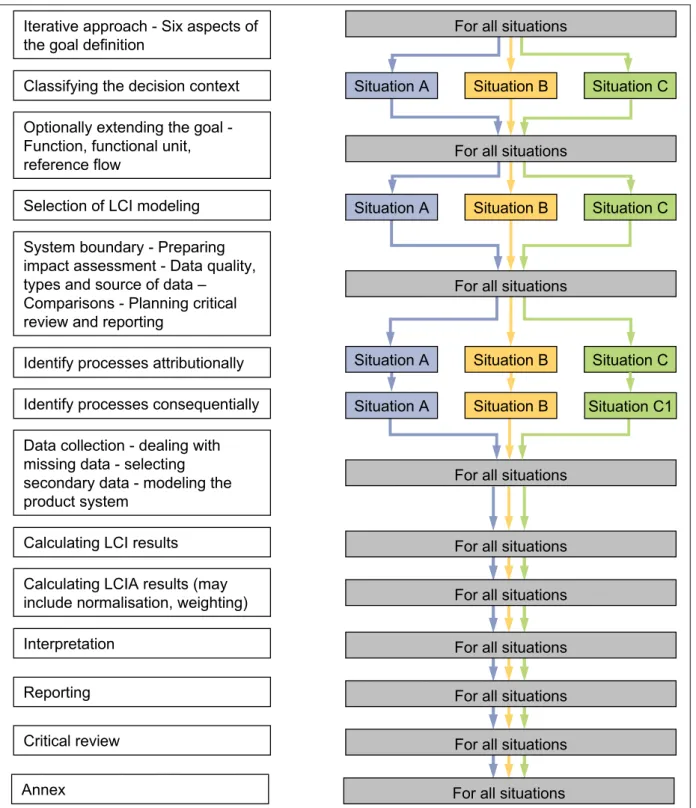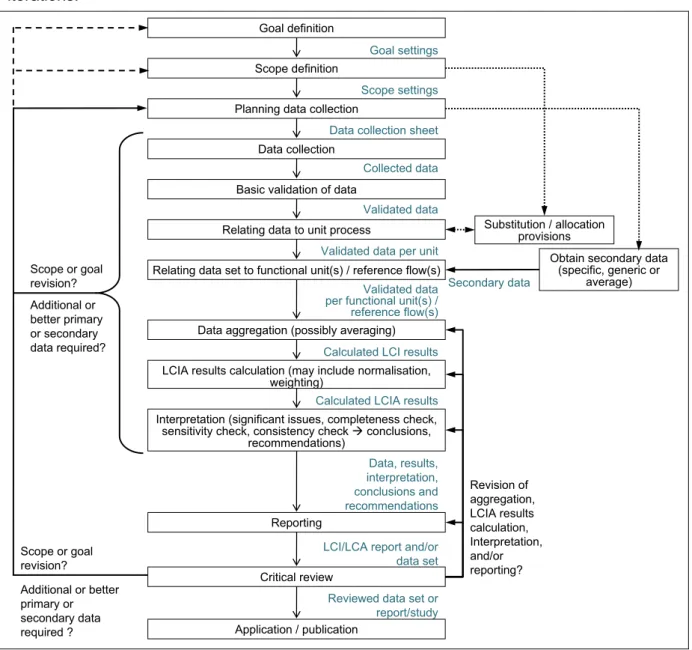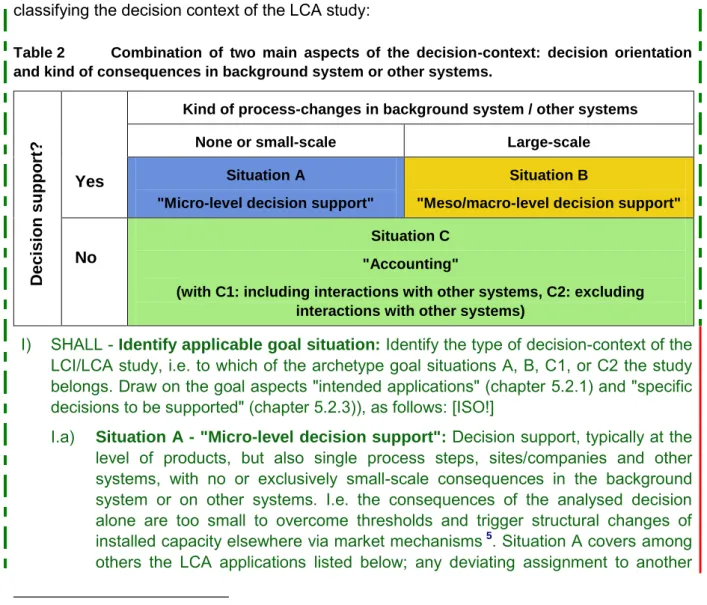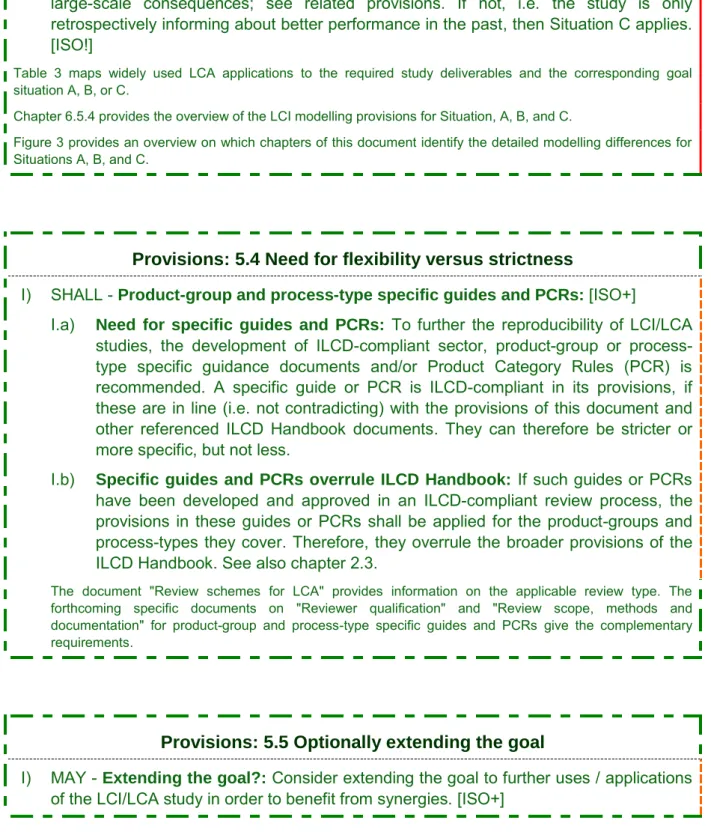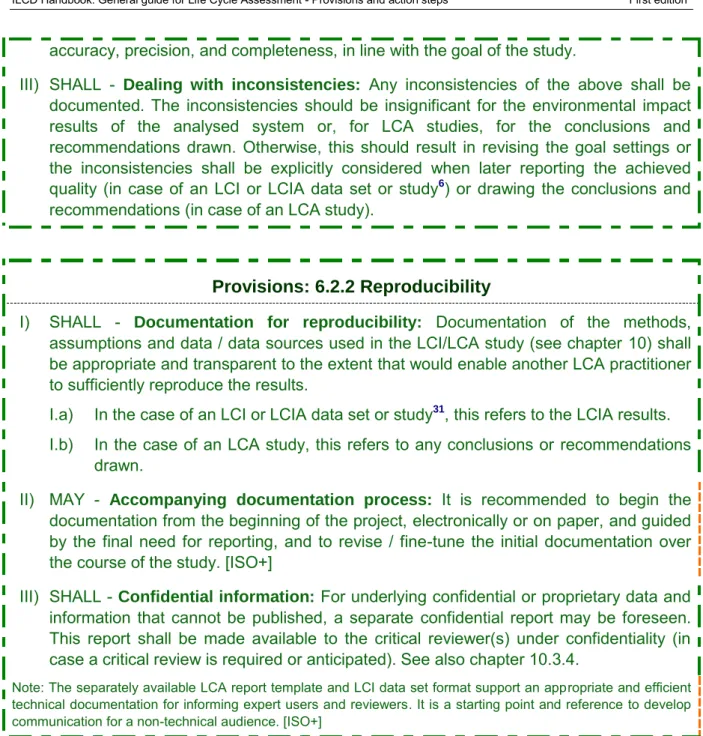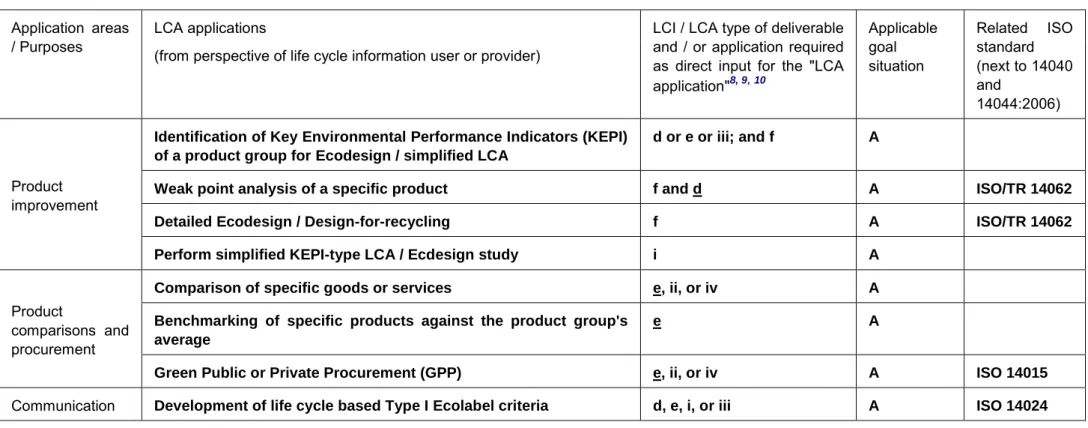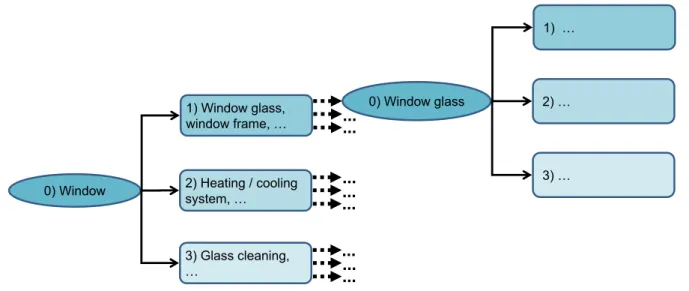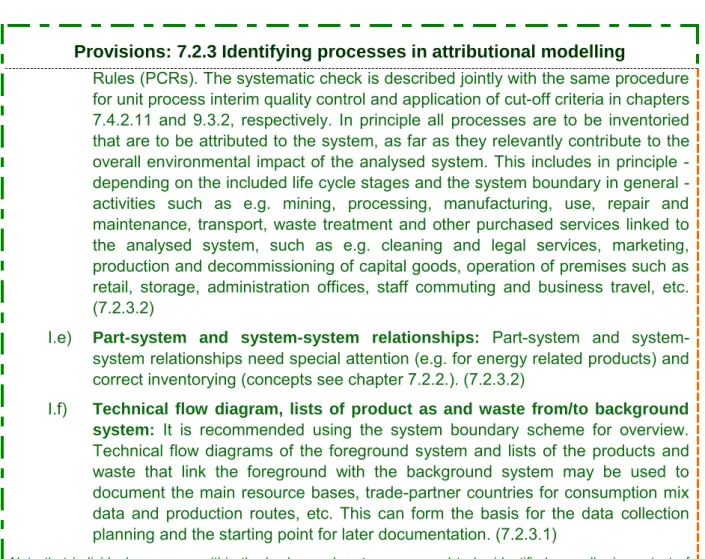environment.
Citation: European Commission - Joint Research Centre - Institute for Environment and
Sustainability: International Reference Life Cycle Data System (ILCD) Handbook - General guide for Life Cycle Assessment - Provisions and Action Steps. First edition March 2010. EUR 24378 EN. Luxembourg. Publications Office of the European Union; 2010.
European Commission Joint Research Centre
Institute for Environment and Sustainability Contact information
Address: Via Enrico Fermi 2749, 21027 Ispra (VA), Italy E-mail: lca@jrc.ec.europa.eu Fax: +39-0332-786645 http://lct.jrc.ec.europa.eu/ http://ies.jrc.ec.europa.eu/ http://www.jrc.europa.eu/ Legal Notice
Neither the European Commission nor any person acting on behalf of the Commission is responsible for the use which might be made of this publication.
Europe Direct is a service to help you find answers to your questions about the European Union
Freephone number (*): 00 800 6 7 8 9 10 11
(*) Certain mobile telephone operators do not allow access to 00 800 numbers or these calls may be billed. A great deal of additional information on the European Union is available on the Internet. It can be accessed through the Europa server http://europa.eu/
JRC 58190 EUR 24378 EN
ISBN 978-92-79-15855-1 ISSN 1018-5593
doi:10.2788/94987
Luxembourg: Publications Office of the European Union © European Union, 2010
Reproduction is authorised provided the source is acknowledged
Preface
To achieve more sustainable production and consumption patterns, we must consider the environmental implications of the whole supply-chain of products, both goods and services, their use, and waste management, i.e. their entire life cycle from “cradle to grave”.
In the Communication on Integrated Product Policy (IPP), the European Commission committed to produce a handbook on best practice in Life Cycle Assessment (LCA). The Sustainable Consumption and Production Action Plan (SCP) confirmed that “(…) consistent and reliable data and methods are required to asses the overall environmental performance of products (…)”. The International Reference Life Cycle Data System (ILCD) Handbook provides governments and businesses with a basis for assuring quality and consistency of life cycle data, methods and assessments.
This 'cook-book' style document provides the provisions and action steps for daily reference when performing ILCD-compliant, detailed Life Cycle Assessment (LCA) studies. The principle target audience for this document is the experienced LCA practitioner and reviewer. It is accompanied by the more comprehensive "General guide for Life Cycle Assessment - Detailed guidance" document.
Executive summary
OverviewLife Cycle Thinking (LCT) and Life Cycle Assessment (LCA) are the scientific approaches behind modern environmental policies and business decision support related to Sustainable Consumption and Production (SCP).
The International Reference Life Cycle Data System (ILCD) provides a common basis for consistent, robust and quality-assured life cycle data and studies. Such data and studies support coherent SCP instruments, such as Ecolabelling, Ecodesign, Carbon footprinting, and Green Public Procurement.
This 'cook-book' style document is a component of the International Reference Life Cycle Data System (ILCD) Handbook (see figure). It provides the provisions and action steps for daily reference when performing ILCD-compliant, detailed Life Cycle Assessment (LCA) studies. It is accompanied by the more comprehensive "General guide for Life Cycle Assessment - Detailed guidance" document.
The principle target audience for this provisions document is the experienced LCA practitioner and reviewer.
This document is based on and conforms to the ISO 14040 and 14044 standards on LCA.
About Life Cycle Assessment (LCA)
Life Cycle Assessment (LCA) is a structured, comprehensive and internationally standardised method. It quantifies all relevant emissions and resources consumed and the related environmental and health impacts and resource depletion issues that are associated with the entire life cycle of any goods or services (“products”).
Life Cycle Assessment is a vital and powerful decision support tool, complementing other methods, which are necessary to help effectively and efficiently make consumption and production more sustainable.
About the International Reference Life Cycle Data System (ILCD)
The ISO 14040 and 14044
standards provide the
indispensable framework for
Life Cycle Assessment
(LCA). This framework,
however, leaves the
individual practitioner with a range of choices, which can affect the legitimacy of the results of an assessment. While flexibility is essential in responding to the large
variety of questions
addressed, further guidance is needed to support
consistency and quality assurance. The International Reference Life Cycle Data System (ILCD) has therefore been developed to provide guidance for consistent and quality assured Life Cycle Assessment data and studies.
The ILCD consists primarily of the ILCD Handbook and the ILCD Data Network.
Review
ISO 14040, 14044
Life Cycle Assessment data and studies for Sustainable Consumption and Production
in government and business Review
ISO 14040, 14044
Life Cycle Assessment data and studies for Sustainable Consumption and Production
in business and government. It is supported by templates, tools, and other components. The ILCD Handbook equally serves as a "parent" document for developing sector and product-group specific guidance documents, criteria, and simplified ecodesign-type tools. Such are seen as the most appropriate solutions to ease the use of reliable and robust life cycle approaches in Small and Medium Enterprises (SME).
The development of the ILCD was initiated by the European Commission and has been carried out through a broad international consultation process with experts, stakeholders, and the public.
Role of this document within the ILCD Handbook
This document provides the provisions and action steps for planning, developing, and reporting both life cycle emission and resource consumption inventory (LCI) data sets and Life Cycle Assessment studies. Much more detailed explanations, illustrations, and overview of main terms and concepts are provided in its sister document "General guide for Life Cycle Assessment - Detailed guidance" document (see figure).
Within the set of ILCD Handbook components, this document has the role of a 'cook-book' style reference document daily practice. Due to its condensed form, it is targeted at the experienced LCA practitioner and reviewer only.
It is complemented by specific guides on the development of Life Cycle Inventory (LCI) data sets, the development of Life Cycle Impact Assessment models & indicators, as well as on performing reviews of LCI data sets and LCA studies.
This document is further supported with an LCA study report template, an LCI data set documentation format, a document on nomenclature and other conventions, and a terminology. These supporting documents and applications are available separately.
Approach taken and key issues addressed in this document
This document further details the ISO 14044 provisions and differentiates them for the three main types of questions that are addressed with LCA studies:
"Micro-level decision support": Life cycle based decision support on micro-level, i.e.
typically for questions related to specific products. “Micro-level decisions” are assumed to have limited and no structural consequences outside the decision-context, i.e. they are supposed not to change available production capacity.
"Meso/macro-level decision support": Life cycle based decision support at a
strategic level (e.g. raw materials strategies, technology scenarios, policy options). “Meso/macro-level decisions” are assumed to have structural consequences outside the decision-context, i.e. they are supposed to change available production capacity.
"Accounting": Purely descriptive documentation of the system's life cycle under
analysis (e.g. a product, sector, or country), without being interested in any potential additional consequences on other parts of the economy.
Focus is given to methodological issues that result in relevant differences in current practice of developing Life Cycle Inventory data sets and performing LCA studies.
CONTENTS
E
XECUTIVE SUMMARY………...……….…...
.
IV1
I
NTRODUCTION AND OVERVIEW... 1
Provisions: 2 How to use this document ... 5
3
K
EY DEFINITIONS... 9
4
T
HE ITERATIVE APPROACH TOLCA ... 13
Provisions: 4 The iterative approach to LCA ...13
5
G
OAL DEFINITION–
IDENTIFYING PURPOSE AND TARGET AUDIENCE... 15
Provisions: 5.2 Six aspects of goal definition ...15
Provisions: 5.3 Classifying the decision-context ...16
Provisions: 5.4 Need for flexibility versus strictness ...19
Provisions: 5.5 Optionally extending the goal ...19
6
S
COPE DEFINITION-
WHAT TO ANALYSE AND HOW... 21
Provisions: 6.2.1 Consistency of methods, assumptions and data ...21
Provisions: 6.2.2 Reproducibility ...22
Provisions: 6.3 Types of LCA deliverables and intended applications ...26
Provisions: 6.4 Function, functional unit, and reference flow ...26
Provisions: 6.5.4 LCI modelling provisions for Situations A, B, and C ...28
Provisions: 6.6 Deriving system boundaries and cut-off criteria (completeness) ...34
Provisions: 6.7 Preparing the basis for the impact assessment ...37
Provisions: 6.8.2 Technological representativeness ...43
Provisions: 6.8.3 Geographical representativeness ...45
Provisions: 6.8.4 Time-related representativeness ...46
Provisions: 6.9 Types, quality and sources of required data and information...47
Provisions: 6.10 Comparisons between systems ...48
Provisions: 6.11 Identifying critical review needs ...51
Provisions: 6.12 Planning reporting...52
7
L
IFEC
YCLEI
NVENTORY ANALYSIS-
COLLECTING DATA,
MODELLING THE SYSTEM,
CALCULATING RESULTS... 53
7.1.3 Identifying processes in attributional modelling ...54
Provisions: 7.2.3 Identifying processes in attributional modelling...56
7.1.4 Identifying processes in consequential modelling ...57
Provisions: 7.2.4 Identifying processes in consequential modelling ...58
Provisions: 7.3 Planning data collection ...66
7.4 Collecting unit process LCI data ...68
Provisions: 7.4.2.2 Avoiding black box unit processes by subdivision and virtual subdivision ...68
Provisions: 7.4.2.3 Describing what the unit process represents...69
Provisions: 7.4.2.4 Types of input and output flows to collect ...70
Provisions: 7.4.2.5 Data and information types for specific, future and generic data sets ...70
Provisions: 7.4.2.6 Reference amount of the reference flow ...71
Provisions: 7.4.2.7 Representativeness regarding operation conditions ...72
Provisions: 7.4.2.11 Interim quality control ...73
Provisions: 7.4.3.3 Emission of measurement indicators and elementary flow groups ...77
Provisions: 7.4.3.3 Emission of ionic compounds ...78
Provisions: 7.4.3.4 Emission of particles to air ...78
Provisions: 7.4.3.6 Resource elementary flows ...79
Provisions: 7.4.3.7 Future processes and elementary flows ...81
Provisions: 7.4.3.8 Reminder flows ...84
Provisions: 7.4.4.1 Modelling agro- and forestry systems ...84
Provisions: 7.4.4.2 Modelling waste treatment ...89
Provisions: 7.4.5 Naming and other conventions ...89
Provisions: 7.6 Selecting secondary LCI data sets ...90
7.8 Modelling the system ...91
Provisions: 7.8 Modelling the system ...91
Provisions: 7.9.2 Avoiding allocation by subdivision or virtual subdivision ...92
Provisions: 7.9.3 Solving multifunctionality by allocation ...93
7.10 Calculating LCI results ... 100
Provisions: 7.10 Calculating LCI results ... 100
8
L
IFEC
YCLEI
MPACTA
SSESSMENT-
CALCULATINGLCIA
RESULTS... 103
Provisions: 8.2 Calculation of LCIA results ... 104
Provisions: 8.3 Normalisation ... 105
Provisions: 8.4 Weighting ... 105
9
L
IFE CYCLE INTERPRETATION... 107
Provisions: 9.2 Identification of significant issues ... 108
Provisions: 9.3.2 Completeness check ... 109
Provisions: 9.3.3 Sensitivity check (of accuracy and precision) ... 111
Provisions: 9.3.4 Consistency check ... 112
Provisions: 9.4 Conclusions, limitations, and recommendations... 112
10
R
EPORTING... 115
Provisions: 10.2 Reporting principles ... 115
Provisions: 10.3 Three levels of reporting requirements ... 116
11
C
RITICAL REVIEW... 123
Provisions: 11 Critical review ... 123
12
A
NNEXA:
D
ATA QUALITY CONCEPT AND APPROACH... 125
13
A
NNEXB:
C
ALCULATION OFCO
2 EMISSIONS FROM LAND TRANSFORMATION... 133
16
A
NNEXE:
S
YSTEM BOUNDARY TEMPLATE... 137
FIGURES
Figure 1 Framework for life cycle assessment (from ISO 14040:2006; modified) ... 1 Figure 2 ILCD Handbook approach of harmonising existing practice in line with ISO 14040
and 14044:2006 ... 2 Figure 3 Main differentiation of the document for the three goal situations A, B, and C
(indicative only; few other differences exist). ... 4 Figure 5 Details of the iterative approach to LCA, with focus on inventory data collection
and modelling (from ISO 14044:2006, modified). ...13 Figure 20 Identifying processes within system boundary, starting from the central process or
analysed system. Example of a window, illustrative.. ...55 Figure 21 Decision tree for consequential modelling.. ...58 Figure 25 The elements of the interpretation phase and their relations to other phases of the
LCA and within the interpretation phase (from ISO 14044:2006, modified) ... 108 Figure 35 System boundary diagram template for technical audience.. ... 137
Table 1 Key terms and definitions ... 9
Table 2 Combination of two main aspects of the decision-context: decision orientation and kind of consequences in background system or other systems. ...16
Table 3 Most common types of LCI/LCA study deliverables required for specific LCA applications (indicative overview).. ...23
Table 5 Overall inventory data quality (validity) and its main 6 aspects ... 126
Table 6 Quality levels and quality rating for the data quality indicators. ... 127
Table 7 Overall quality level of a data set according to the achieved overall data quality rating ... 128
Table 9 ILCD compliance of LCI and LCA studies and data sets, direct applications, and derived more specific guidance documents / Product Category Rules (PCR).... 129
Table 10 Native soil carbon stocks under native vegetation ... 133
Table 11 Land use factors ... 134
Table 12 Land management and input level factors for cropland ... 135
Table 13 Land management and input level factors for grassland ... 136
1 Introduction and overview
Overview
This guide is a component of the International Reference Life Cycle Data System (ILCD) Handbook. It provides the provisions and action steps for planning, developing, and reporting both LCI data sets and LCA studies.
The overall objective of the ILCD Handbook is to provide a common basis for consistent and quality-assured life cycle data and robust studies. These support coherent and reliable Sustainable Consumption and Production (SCP) policies and solid decision support in the public and private sectors related to products, resources and waste management.
Scope of this document
This 'cook-book' style document provides the provisions and action steps for ILCD compliant Life Cycle Inventory (LCI) and Life Cycle Assessment (LCA) studies as covered by the ISO 14040 and 14044:2006 standards.
The outcome of LCI and LCA studies is the basis for all types of applications of LCA. Figure 1 shows the Life Cycle Assessment framework.
Figure 1 Framework for life cycle assessment (from ISO 14040:2006; modified)
Table 3 lists the most widely used LCA applications and their relationship to the provisions provided in this document. The subsequent use of the LCI data and LCA studies in other LCA applications is not within the scope of this document; this is analogous to ISO 14044:2006.
Approach taken and relationship to ISO 14044
The relevant ISO 14040 and 14044:2006 standards, a range of Life Cycle Assessment manuals, and the general LCA literature have been analysed to identify the “needs for guidance” and to obtain input in the form of good practice approaches and arguments. Together with the extensive and detailed input and feedback received in the invited and
Life cycle assessment framework
Goal definition Scope definition Inventory analysis Impact assessment Direct applications: •Product development and improvement •Strategic planning •Public policy making •Marketing
•Other
The contributors and the sources consulted are documented in annex 18. An Explanatory Memorandum is separately available.
Figure 2 ILCD Handbook approach of harmonising existing practice in line with ISO 14040 and 14044:2006
A more comprehensive introduction to the "General guide on LCA", the approach taken, principal method issues addressed, and relationship to the ISO 14040 and 14044:2006 standards can be found in the Introduction chapter of the "General guide on LCA - Detailed guidance" document.
Provisions and action steps plus key tables and figures
This document presents the "Provisions" for ILCD-compliant LCA work. It follows the main structure of ISO 14044:2006.
These Provisions are complemented by brief introduction and overview paragraphs at the beginning of the principal chapters, and by the principal tables and figures that directly support the Provisions.
Chapter numbers and cross-references to the main text chapters of the sister document "General guide to LCA - Detailed guidance" are kept to ease cross-checking with the detailed guidance texts.
Related topics addressed in other ILCD Handbook components
A number of nomenclature and other conventions help to improve compatibility of data sets developed throughout this document, and aid an understanding of LCA study reports developed by different experts. Further detail is provided in the separate document "Nomenclature and other conventions".
The electronic LCI data set format supports effective and compatible reporting of LCI data sets. It is supported by a data set editor application and a complete set of reference elementary flows, flow properties and units. Both the report template and the data set format are referenced from chapters 6.12 and 10.
National LCA project XY-land Manual for LCI data modelling
National LCA project XY-land Manual for LCI data modelling
National LCA project
Country X Manual for LCI data modelling XY Association Method handbook for LCA of XY products XY Association Method handbook for LCA of XY products XY Association Method handbook for LCA of XY products XY Research & Consulting Centre Attributional LCA method manual XY Research & Consulting Centre Attributional LCA method manual XY Research & Consulting Centre Attributional LCA method manual
Guidance for developers of Life Cycle Impact Assessment (LCIA) models, methods and indicators is given in the separate document "Framework and requirements for Life Cycle Impact Assessment (LCIA) models and indicators". In this guide, chapter 6.7 points to that document. This topic is supported by the background document "Analysis of existing Environmental Impact Assessment methodologies for use in Life Cycle Assessment (LCA)".
The detailed provisions for reviewing LCI and LCA studies and data sets are given in the separate guidance documents on "Review schemes for Life Cycle Assessment (LCA)", "Reviewer qualification", and "Review scope, methods, and documentation". In this document, chapters 6.11 and 11 refer to these documents.
Overview of differences in the provisions for the Situations A, B, and C
The overview graphic of Figure 3 identifies the chapters which have substantially different provisions for the individual goal situations A, B, and C. Note that a few other chapters that apply to all situations have single aspects that are differentiated for the three goal situations.
The main differences between the archetypal goal Situations A, B, and C lie in the LCI modelling. In a condensed form for overview, this document makes the following specific provisions. Effectively, there are only a few but very relevant and necessary differences in which the provisions for these Situations differ. (NB: If you are not familiar with the used terms and concepts, please see the main text chapters in the "Detailed guidance" document):
Situation A: This comprises micro-level, product or process-related decision support
studies. The life cycle is modelled by depicting the existing supply-chain, i.e. attributionally. The foreground system should aim at using primary data from the producer / operator and secondary data from suppliers and downstream users/customers. Background processes should represent the average market consumption mix. Generic data from third-party data providers can be used for the background system. They can also be used for the foreground system if they are of better overall quality for the given case than available primary or secondary data from direct suppliers or downstream operators. Cases of general multifunctionality, of recycling, and of reuse and recovery are preferably solved via subdivision or virtual subdivision. If this is not possible or feasible, then a substitution of the market mix of the not required co-functions should be performed as second alternative (excluding the substituted co-function from this mix). If also this is not possible or feasible, then allocation is the third, alternative solution. Detailed guidance is given for these three options. If the second or third alternative is used, the resulting lack in accuracy shall be explicitly reported and considered in the results interpretation. "Assumption scenarios" of data, parameters, and method assumptions shall be performed for comparative LCA studies; exclusively the "shall" provisions cannot be rejected in these scenarios. Uncertainty calculation can support the analysis of the robustness of the results.
Situation B: This comprises meso-level and macro-level, strategic ("policy") decision
support studies. The analysed systems shall be modelled as in Situation A, except for those processes in the background system that are affected by large-scale consequences of the analysed decision. These are modelled with the mix of the long-term marginal processes / systems. Contrary to Situation A, the assumption scenarios can also vary the "shall" provisions; the assumption scenarios and uncertainty calculation shall be defined via a best attainable consensus among the interested parties.
Situation C: Most monitoring type studies fall into Situation C1; Situation C2 studies are
less common. For Situation C1, the life cycle and all cases of multifunctionality are modelled as in Situation A. In contrast to Situation A, this also applies to macro-level monitoring studies under Situation C1, i.e. independent from the absolute size of the system (e.g. 1 t or
For Situation C2, the life cycle is equally modelled as in Situation A, but multifunctionality shall always be solved via allocation, through application of the detailed allocation guidance provided.
Figure 3 Main differentiation of the document for the three goal situations A, B, and C (indicative only; few other differences exist).
Note that across all goal Situations the same life cycle model can chiefly be used, except for cases of multifunctionality that need to be switched between substitution and allocation, Critical review
Optionally extending the goal -Function, functional unit, reference flow
Identify processes attributionally
Data collection - dealing with missing data - selecting secondary data - modeling the product system
Calculating LCI results
Calculating LCIA results (may include normalisation, weighting) Iterative approach - Six aspects of the goal definition
Interpretation Reporting
Classifying the decision context
Selection of LCI modeling System boundary - Preparing impact assessment - Data quality, types and source of data –
Comparisons - Planning critical review and reporting
Identify processes consequentially
For all situations
For all situations For all situations For all situations For all situations For all situations
Annex For all situations
For all situations
For all situations
For all situations
Situation A Situation B Situation C
Situation A Situation B Situation C
Situation C Situation A Situation B
depending on the applicable Situation. Additionally, the very few processes that are typically affected by large-scale consequences under Situation B, need to be modelled differently: These processes need to be the long-term marginal mixes (note that for these processes the upstream or downstream life cycles will be different as well).
Other differences in the guidance for Situations A, B, and C
A few more differences exist in the provisions for Situations A, B, and C. The more relevance ones are:
The general critical review requirements of ISO 14040 and 14044 are specified in the separate documents "Review schemes for Life Cycle Assessment (LCA)", "Reviewer qualification", and "Review scope, methods and documentation". This includes the provisions on the applicable type of review for different types of studies and audiences, on the qualification of the reviewer, and regarding what and how to review.
Finally, as another key item of further specification, the ISO 14044 provisions for "comparative assertions disclosed to the public" are extended also to most non-assertive but comparative LCA studies.
Provisions: 2 How to use this document
I) SHALL1 -ILCD Handbook compliance: An LCI or LCA study or data set and direct
LCA applications can claim compliance with the ILCD Handbook. For this they shall have been developed in line with the provisions of this document as specified in the "Provisions", including the provisions made in referenced documents and complementing information that may be given in the main part of the document, e.g. in supporting tables or in the "terms and concepts" boxes. Also specific LCI / LCA guidance documents (e.g. product-group, sector or process-type specific guides) and Product Category Rules (PCR) can claim ILCD compliance. This applies, if their provisions are compliant with the broader provisions of the ILCD Handbook and if they have undergone an ILCD compliant review as specified in the separate document "Review schemes for LCA". The following applies to compliance statements (2.32): [ISO+]3
I.a) The compliance statement shall refer to the applicable Situation A, B, C1, and/or C2.
I.b) ILCD compliance is structured into five compliance aspects that shall all be met for full compliance: Data quality, Method, Nomenclature, Review, and Documentation (chapter 12.4 gives the details).
I.c) Partial compliance can be claimed in a structured way by referring to any of the above five aspects, but it shall be clearly communicated in such cases that full compliance has not been achieved.
I.d) Purely methodological LCA studies may not be able to comply with the ILCD
1
The meaning of the SHALL, SHOULD and MAY settings is explained in Provision II) in this set of "Provisions: 2 How to use this document".
2
The sub-chapter of the main text that has more details on a specific provision is given in brackets at the end of the main provision.
3
The meaning of the (ISO!) and [ISO+] settings is explained in Provision III) in this set of "Provisions: 2 How to use this document".
the ILCD provisions, but compliance with the ILCD Handbook cannot be claimed in such cases and the impression shall be avoided as far as possible that they are compliant. Partial compliance can be reported, as detailed above.
I.e) Additionally, for LCI data sets, the overall data quality level attained should be documented in the data set as "High quality", "Basic quality", or "Data estimate" (see chapter 12.3 and tables of that chapter for details and definitions). The performed review type and reviewer(s), if any, shall also be identified in the data set.
I.f) When claiming compliance, the applied version or edition of the ILCD "General guide for LCA" shall be identified in connection to the claim.
I.g) When a new version of an ILCD Handbook component has been published, the provisions of that new version shall be applied, overruling the ones of the former version. The provisions of the preceding version can per default still be applied for ongoing studies up to a maximum of 9 months after publication of the new version. These 9 months can be modified and overruled by different provisions of ILCD system operators. If a new version of any applicable ILCD component has been published but an older version is used, the name of the component and the publication date of the new version shall be clearly and in a prominent place be identified in the study report or other deliverable that claims compliance.
II) SHALL - Shall, should, may: The expression "SHALL", "SHOULD" and "MAY" in front
of a (main) provision identifies its requirement status (2.3): (ISO!)
II.a) "SHALL": the provision is a mandatory requirement and must always be followed, unless for specifically named exceptions, if any.
II.b) "SHOULD": the provision must be followed; deviations are permissible if they are clearly justified in writing for the given case, giving appropriate details. Reasons for deviations can be that the respective provision or parts of it are not applicable, or if another solution is clearly more appropriate. If the permissible deviations and justifications are restricted, these are identified in the context of the provision. II.c) "MAY": the provision is only a methodological or procedural recommendation. The
provision can be ignored or the issue addressed in another way without the need for any justification or explanation. NOTE: Instead of "may" the equivalent term "recommended" is sometimes used.
II.d) The requirement status also applies to all subsequent provisions on a lower hierarchy-level (e.g. under a provision "II" also all sub-provisions "II.a", "II.b", etc.). If a provision is differentiated (e.g. a "should" or "may" under a "shall" provision), this is explicitly formulated in the provisions text.
III) For information/orientation only - ISO specifications and additions: Single
provisions on items that are not covered by ISO 14044:2006 are generally marked as "[ISO+]"; additionally the right border of the frame next to that provision is a dashed orange line (instead of the default dotted-dashed green line). Provisions where the ILCD provisions are more strict or specific than that which follows from applying ISO 14044:2006 are generally marked as "[ISO!]"; furthermore, the right border of the frame next to that provision is a solid red line. [ISO+]
with ISO 14040 and 14044:2006, in the sense that an ILCD compliant study will also conform with ISO 14040 and 14044:2006. If conformity with ISO 14040 and 14044:2006 is aimed at for an LCI or LCA study, it is nevertheless recommended to have this confirmed as part of a critical review.
V) SHALL - Contradictions or inapplicabilities: In the case of contradictions among
provisions, or inapplicability of any provision in the ILCD Handbook (i.e. in this document and other ILCD Handbook documents), an LCI or LCA study can claim compliance with the ILCD Handbook if the following three requirements are met by the study (2.4):
V.a) a) All other, unaffected provisions of the ILCD Handbook documents have been applied.
V.b) b) The general or case-specific contradiction or inapplicability is clearly identified and demonstrated. In such cases, the provision shall be used that best meets the ISO 14040 and 14044:2006 requirements.
V.c) c) If a critical review is required: The reviewer is confirming the compliance of the study or other deliverable to the above two requirements a) and b).
VI) MAY - How to work with this document: Stepwise recommendations are made on
how to efficiently perform an LCI or LCA study with the help of this document and the general frame of ISO 14044 (2.2.4). [ISO+]
VII) MAY - Differences A, B, C1, C2: A condensed, indicative overview is given on the
main LCI modelling differences among the Goal Situations A, B, C1, and C2 (2.2.3). [ISO+]
3 Key definitions
The following key definitions are newly introduced terms or ISO terms that are used by different LCA practitioners with different meanings. These definitions should be read first for a clearer understanding of this document.
Table 1 Key terms and definitions
Term Definition
Allocation [or:
Partitioning] Partitioning the input or output flows of a process or a product system between the product system under study and one or more other product systems. [Source: ISO 14044:2006]
Analysed decision Decision that is subject to an LCA study. In contrast to LCI studies and most non-comparative LCA studies stand comparative LCA studies with a direct decision context. For these the LCA study analysis a decision rather than a single process or system.
Such can be for example the decision on alternative materials that are evaluated to be used for a product, the purchase of alternatives products that are compared, the decision on a policy option that is analysed regarding its environmental impact implications, and the like.
Assumption scenario Scenario for the analysed process or system that varies data and method assumptions with the purpose of evaluating the robustness of the study results and conclusions. If more than one alternative system or option are compared, each of them would have its own assumption scenarios.
Attributional
modelling [or: descriptive, book-keeping]
LCI modelling frame that inventories the inputs and output flows of all processes of a system as they occur.
Modelling process along an existing supply-chain is of this type. Best attainable
consensus Partial or full agreement of the involved parties, steered by a chair or coordinator towards the broadest possible agreement on the issue at stake. In contrast to an entirely result-open process, here a solution that fits preset requirements (e.g. "define a reasonably worst case scenario") is to be found, i.e. the 'zero-option' is not an option.
Co-function Any of two or more functions provided by the same unit process or system. Co-product Any of two or more products coming from the same unit process or
system. [Source: ISO 14044:2006] Comparative
assertion Environmental claim regarding the superiority or equivalence of one product versus a competing product that performs the same function. [ISO 14040:2006, ISO 14025:2006]
Comparative life
cycle assessment Comparison of LCA results for different products, systems or services that usually perform the same or similar function. Consequential
modelling LCI modelling principle that identifies and models all processes in the background system of a system in consequence of decisions made in the foreground system
Disclosed to the
Environmental impact Potential impact on the natural environment, human health or the depletion of natural resources, caused by the interventions between the technosphere and the ecosphere as covered by LCA (e.g. emissions, resource extraction, land use).
Functional flow One of the (co-)product flow(s) in the inventory of a process or system that fulfils the process' / system's function
See also: Non-functional flow Monofunctional
process Process or system that performs only one function. Non-functional flow Any of the inventory items that are not (co-)product flows.
E.g. all emissions, waste, resources but also input flows of processed goods and of services.
Multifunctional
process Process or system that performs more than one function. Examples: Processes with more than one product as output (e.g. NaOH, Cl2 and H2 from Chloralkali electrolysis) or more than one waste treated jointly (e.g. mixed household waste incineration with energy recovery). See also: "Allocation" and "System expansion"
Life cycle inventory
(LCI) data set Data set with the inventory of a process or system. Can be both unit process and LCI results and variants of these. Life cycle inventory
(LCI) study Life cycle study that provides the life cycle inventory data of a process or system. Life cycle inventory
analysis results (LCI results)
Outcome of a life cycle inventory analysis that catalogues the flows crossing the system boundary and provides the starting point for life cycle impact assessment. (Source: ISO 14040)
Overall
environmental impact Total of impacts on human health, natural environment and resource depletion for the considered impact categories. It can be calculated either as normalised and weighted overall LCIA results of the analysed process / system, or assuming an even weighting across impacts, i.e. for each and any of the impact categories.
Product Any good or service; see "System". Recycling, reuse,
recovery Note: In lack of a common parent term, these three terms are used in this document to identify these and similar activities, such as refurbishing, further use and the like. Casewise also the term "recycling" alone is used and meant to cover the entirety of these activities.
See also "Secondary good".
Relevant For LCI data sets: Having a significant influence on or contribution to the overall environmental impact of the analysed process or system, resulting in a different quality level.
For LCA studies: Having a significant influence on or contribution to the overall environmental impact of the analysed process or system, resulting
in different conclusions or recommendations.
Secondary good Secondary material, recovered energy, reused part or similar as the product of a reuse, recycling, recovery, refurbishing or similar process. Substitution Solving multifunctionality of processes and products by expanding the
system boundaries and substituting the not required function with an alternative way of providing it, i.e. the process(es) or product(s) that the not required function supersedes. Effectively the life cycle inventory of the superseded process(es) or product(s) is subtracted from that of the analysed system, i.e. it is "credited". Substitution is a special (subtractive) case of applying the system expansion principle.
System Any good, service, event, basket-of-products, average consumption of a citizen, or similar object that is analysed in the context of the LCA study. Note that ISO 14044:2006 generally refers to "product system", while broader systems than single products can be analysed in an LCA study; hence here the term "system" is used. In many but not all cases the term will hence refer to products, depending on the specific study object. Moreover, as LCI studies can be restricted to a single unit process as part of a system, in this document the study object is also identified in a general way as "process / system"
System expansion Adding specific processes or products and the related life cycle inventories to the analysed system. Used to make several multifunctional systems with an only partly equivalent set of functions comparable within LCA.
System perspective In contrast to a unit process or a part of a life cycle, the system perspective relates to the entire life cycle of an analysed system or process. For processes that implies that the life cycle is completed.
This term is used mainly in context of identifying significant issues and quantifying inventory completeness / cut-off.
Unit process Smallest element considered in the life cycle inventory analysis for which input and output data are quantified. (Source: ISO 14040)
In practice of LCA, both physically not further separable processes (such as unit operations in production plants) and also whole production sites are covered under "unit process". See also "Unit process, black box", "Unit process, single operation", and "System".
Unit process, black
box A unit process that includes more than one single-operation unit processes. Unit process, single
operation A unit process that cannot be further sub-divided into included processes. Some, more complex terms and concepts are explained in more detail in boxes throughout the document. See the contents of these "Terms and concepts" after the "Contents" of this document.
4 The iterative approach to LCA
Figure 5 gives an overview of the main steps of carrying out an LCA study, including the iterations.
Figure 5 Details of the iterative approach to LCA, with focus on inventory data collection and modelling (from ISO 14044:2006, modified).
Provisions: 4 The iterative approach to LCA
I) MAY - Overview of iterative approach: It is recommended taking an iterative
approach to the LCI/LCA study (for more detail see chapter 2.2.4):
I.a) Define the goal aspects as precisely as possible in the beginning of the study (see chapter 5.2).
I.b) Derive an initial scope definition from the goal definition as far as initial knowledge permits (see chapter 6).
I.c) Compile easily available Life Cycle Inventory data for the foreground and
Calculated LCIA results Scope settings Goal settings
Reviewed data set or report/study LCI/LCA report and/or
data set Critical review Data, results, interpretation, conclusions and recommendations Secondary data Additional or better primary or secondary
data required? Calculated LCI results
Validated data per unit process Collected data Validated data
Validated data per functional unit(s) /
reference flow(s) Data collection sheet
Scope definition
Planning data collection
Data collection
Basic validation of data
Relating data to unit process
Relating data set to functional unit(s) / reference flow(s)
Data aggregation (possibly averaging)
LCIA results calculation (may include normalisation, weighting)
Substitution / allocation provisions
Obtain secondary data (specific, generic or
average) Goal definition
Interpretation (significant issues, completeness check, sensitivity check, consistency check conclusions,
recommendations) Reporting Application / publication Additional or better primary or secondary data required ? Scope or goal revision? Scope or goal revision? Revision of aggregation, LCIA results calculation, Interpretation, and/or reporting?
I.d) Calculate the LCIA results (see chapter 8).
I.e) Identify significant issues and perform first sensitivity, consistency and completeness checks on this initial model (see chapter 9).
I.f) Based on this go to the next iteration: Start with fine-tuning or revising the scope (in some cases even the goal), improve the life cycle model accordingly, etc. I.g) Expect two to four iterations towards completing the study. This will mainly
depend on the quality needs or ambition, the complexity of the analysed process(es) or system(s), on the specifically analysed question(s), and data availability and its quality. [ISO+]
I.h) Starting from the beginning of the study, document the details of the initial goal and scope definition, key LCI and LCIA items, and the key initial results of the sensitivity, consistency and completeness checks. Let this be guided by the main provisions of reporting required for the deliverable. During subsequent iterations, use this preliminary core report as work in progress and constantly revise, fine-tune and complete it towards the final report (be it a data set and/or a study report). [ISO+]
II) MAY - Early identification of reviewers: From the beginning of the study, it is
recommended to identify and involve critical reviewer(s) and - if required or desired - interested parties, including when defining goal and scope. [ISO+]
All these provisions refer especially to the system(s) modelled under Situation B (i.e. for meso / macro-level decision support studies) .
5 Goal definition – identifying purpose and target
audience
Introduction
The goal definition is the first phase of any life cycle assessment, independently whether the LCI/LCA study4 is limited to the development of a single unit process data set or it is a complete LCA study of a comparative assertion to be published.
During the goal definition among others the decision-context(s) and intended application(s) of the study are identified and the targeted audience(s) are to be named.
The goal definition is decisive for all the other phases of the LCA:
The goal definition guides all the detailed aspects of the scope definition, which in turn
sets the frame for the LCI work and LCIA work.
The quality control of the work is performed in view of the requirements that were
derived from the goal of the work.
If the work goes beyond an LCI study, the final results of the LCA are evaluated and
interpreted. Also this is to be done in close relation to the goal of the work.
Provisions: 5.2 Six aspects of goal definition
I) SHALL - Intended applications: Unambiguously identify the intended applications of
the deliverable of the LCI or LCA study (5.2.1).
II) SHALL - Limitations of study: Unambiguously identify and detail any initially set
limitations for the use of the LCI/LCA study. These can be caused by the following (5.2.2):
II.a) Impact coverage limitations such as in Carbon footprint calculations
II.b) Methodological limitations of LCA in general or of specific method approaches
applied
II.c) Assumption limitations: Specific or uncommon assumptions / scenarios
modelled for the analysed system [ISO+]
Note that the initially identified limitations may need to be adjusted during the later LCA phases when all the related details are clear.
Other possible limitations due to lack of achieved LCI data quality may also restrict the applicability; these are identified in the later interpretation phase of the study.
III) SHALL - Reasons for study: Unambiguously identify the internal or external reason(s)
for carrying out the study and the specific decisions to be supported by its outcome, if applicable (5.2.3).
IV) SHALL - Target audience of study: Unambiguously identify the audience(s) to whom
the results of the study are foreseen to be communicated (5.2.4).
4
The term "LCI/LCA study" is used wherever the text applies to both LCI studies (i.e. with a life cycle inventory as deliverable, e.g. a LCI data set) and LCA studies (which is often comparative and always includes an interpretation and potentially conclusions and recommendations).
(e.g. specific business-to-business customers)
Differentiate also between “technical” and ”non-technical” audience (5.2.4). [ISO+] VI) SHALL - Comparisons involved?: Unambiguously state whether the study involves
comparisons or comparative assertions across systems (e.g. products) and whether these are foreseen to be disclosed to the public (5.2.5). [ISO!]
VII) SHALL - Commissioner: Identify the commissioner of the study and all other influential
actors such as co-financiers, LCA experts involved, etc. (5.2.6).
Provisions: 5.3 Classifying the decision-context
Applicable to Situation A, B, and C, differentiated.
Table 2 gives an overview of the resulting, practically relevant three archetype goal situations that will be referred to throughout this document to provide the required, differentiated methodological guidance. This relates to the subsequent provisions on classifying the decision context of the LCA study:
Table 2 Combination of two main aspects of the decision-context: decision orientation and kind of consequences in background system or other systems.
D ec ision sup po rt ? Yes
Kind of process-changes in background system / other systems
None or small-scale Large-scale
Situation A
"Micro-level decision support"
Situation B
"Meso/macro-level decision support"
No
Situation C "Accounting"
(with C1: including interactions with other systems, C2: excluding interactions with other systems)
I) SHALL - Identify applicable goal situation: Identify the type of decision-context of the
LCI/LCA study, i.e. to which of the archetype goal situations A, B, C1, or C2 the study belongs. Draw on the goal aspects "intended applications" (chapter 5.2.1) and "specific decisions to be supported" (chapter 5.2.3)), as follows: [ISO!]
I.a) Situation A - "Micro-level decision support": Decision support, typically at the
level of products, but also single process steps, sites/companies and other systems, with no or exclusively small-scale consequences in the background system or on other systems. I.e. the consequences of the analysed decision alone are too small to overcome thresholds and trigger structural changes of installed capacity elsewhere via market mechanisms 5. Situation A covers among others the LCA applications listed below; any deviating assignment to another
5
Note that these small-scale consequences shall not be interpreted, as per se resulting in large-scale
goal situation than A shall be justified and be in line with the above provisions (see also the specific provisions below for differentiating between Situation A and B, and between Situation C and A/B):
Identification of Key Environmental Performance Indicators (KEPI) of a product
group for Ecodesign / simplified LCA
Weak point analysis of a specific product Detailed Ecodesign / Design-for-recycling
Perform simplified KEPI-type LCA / Ecdesign study Comparison of specific goods or services
Benchmarking of specific products against the product group's average Green Public or Private Procurement (GPP)
Development of life cycle based Type I Ecolabel criteria
Development of Product Category Rules (PCR) or a similar specific guide for a
product group
Development of a life cycle based Type III environmental declaration (e.g.
Environmental Product Declaration (EPD)) for a specific good or service
Development of the 'Carbon footprint', 'Primary energy consumption' or similar
indicator for a specific product
Greening the supply chain
Providing quantitative life cycle data as annex to an Environmental Technology
Verification (ETV) for comparative use
Clean Development Mechanism (CDM) and Joint Implementation (JI)
Development of specific, average or generic unit process or LCI results data
sets for use in Situation A
I.b) Situation B - "Meso/macro-level decision support": Decision support for
strategies with large-scale consequences in the background system or other systems. The analysed decision alone is large enough to result via market mechanisms in structural changes of installed capacity in at least one process outside the foreground system of the analysed system. Situation B covers among others the LCA applications listed below; any deviating assignment to a goal situation other than B shall be justified and be in line with the above provisions (see also the specific provisions below for differentiating between Situation A and B and between Situation C and A/B):
Policy development: Forecasting & analysis of the environmental impact of
pervasive technologies, raw material strategies, and related policy development
Policy information: Identifying product groups with the largest environmental
improvement potential
Development of specific, average or generic unit process or LCI results data
sets for use in Situation B
It is important to note that the LCI modelling provisions for Situation B (see chapter 6.5.4.3) refer exclusively to those processes that are affected by these large-scale consequences. The other parts of the background system of the life cycle model will later be modelled as "Situation A", i.e.
retrospective accounting / documentation of what has happened (or will happen based on extrapolating forecasting), with no interest in any additional consequences that the analysed system may have in the background system or on other systems. Situation C has two sub-types: C1 and C2. C1 describes an existing system but accounts for interactions it has with other systems (e.g. crediting existing avoided burdens from recycling). C2 describes an existing system in isolation without accounting for the interaction with other systems. This may cover the LCA applications listed below; any deviating assignment to a goal situation other than C1 or C2 shall be justified and be in line with the above provisions. See also the specific provision below for differentiating between Situation C and A/B:
I.c.i) Situation C1 - "Accounting with interactions":
Monitoring environmental impacts of a nation, industry sector, product group, or product
Policy information: Basket-of-products (or -product groups) type studies
Policy information: Identifying product groups with the largest environmental impact
Corporate or site environmental reporting including indirect effects under Environmental Management Systems (EMS)
Certified supply type studies or parts of the analysed system with fixed guarantees along the supply-chain
Development of specific, average or generic unit process or LCI results data sets for use in Situation C1
I.c.ii) Situation C2 - "Accounting without interactions":
Accounting studies that according to their goal definition do not include any interaction with other systems
Development of specific, average or generic unit process or LCI results data sets for use in Situation C2
Note that any decision support that would be derived needs to employ the methods under Situation A or B, with Situation C having a preparatory role only. Note however that due to the simplified provisions of this document, the modelling of Situation A studies (micro-level decision support) is identical to that of Situation C1 studies, but not vice versa.
II) SHALL - Situation A or B: Where a study cannot initially be clearly assigned to either
Situation A or B, for example when analysing major strategies of market-dominating companies or product-related questions of market-dominating products. In this situation, the guiding criteria shall be whether the consequences of the analysed decision alone are big enough to overcome related thresholds and/or other constraints and result in large-scale consequences in the installed production capacity outside the foreground system. Then: Situation B. If not: Situation A. Large-scale consequences shall generally be assumed if the annual additional demand or supply, triggered by the analysed decision, exceeds the capacity of the annually replaced installed capacity of the additionally demanded or supplied process, product, or broader function, as applicable.
If that percentage is bigger than 5 %, 5 % should be used instead. [ISO!]
III) SHALL - Situation C1 or A/B: In the case a study cannot initially be clearly assigned to
either Situation C1 or A/B, for example when it is a monitoring study but involves a comparative decision support. In this situation the guiding criteria shall be whether a comparative decision support is to be given by the LCI/LCA study, i.e. whether the study shall be used to support decisions on alternatives with better or worse environmental performance. Then Situation A or B applies, depending on small-scale or large-scale consequences; see related provisions. If not, i.e. the study is only retrospectively informing about better performance in the past, then Situation C applies. [ISO!]
Table 3 maps widely used LCA applications to the required study deliverables and the corresponding goal situation A, B, or C.
Chapter 6.5.4 provides the overview of the LCI modelling provisions for Situation, A, B, and C.
Figure 3 provides an overview on which chapters of this document identify the detailed modelling differences for Situations A, B, and C.
Provisions: 5.4 Need for flexibility versus strictness
I) SHALL - Product-group and process-type specific guides and PCRs: [ISO+]
I.a) Need for specific guides and PCRs: To further the reproducibility of LCI/LCA
studies, the development of ILCD-compliant sector, product-group or process-type specific guidance documents and/or Product Category Rules (PCR) is recommended. A specific guide or PCR is ILCD-compliant in its provisions, if these are in line (i.e. not contradicting) with the provisions of this document and other referenced ILCD Handbook documents. They can therefore be stricter or more specific, but not less.
I.b) Specific guides and PCRs overrule ILCD Handbook: If such guides or PCRs
have been developed and approved in an ILCD-compliant review process, the provisions in these guides or PCRs shall be applied for the product-groups and process-types they cover. Therefore, they overrule the broader provisions of the ILCD Handbook. See also chapter 2.3.
The document "Review schemes for LCA" provides information on the applicable review type. The forthcoming specific documents on "Reviewer qualification" and "Review scope, methods and documentation" for product-group and process-type specific guides and PCRs give the complementary requirements.
Provisions: 5.5 Optionally extending the goal
I) MAY - Extending the goal?: Consider extending the goal to further uses / applications
6 Scope definition - what to analyse and how
Introduction
During the scope definition phase the object of the LCI/LCA study (i.e. the exact product or other system(s) to be analysed) is identified and defined in detail. This shall be done in line with the goal definition. Next and main part of the scope definition is to derive the requirements on methodology, quality, reporting, and review in accordance with the goal of the study, i.e. based on the reasons for the study, the decision-context, the intended applications, and the addressees of the results.
When deriving the scope of an LCI/LCA study from the goal, the following scope items shall be clearly described and/or defined:
The type(s) of the deliverable(s) of the LCI/LCA study, in line with the intend
application(s) (chapter 6.3)
The system or process that is studied and its function(s), functional unit, and reference
flow(s) (chapter 6.4, which names case-specific provisions)
LCI modelling framework and handling of multifunctional processes and products
(chapter 6.5)
System boundaries, completeness requirements, and related cut-off rules (chapter 6.6) LCIA impact categories to be covered and selection of specific LCIA methods to be
applied as well as - if included - normalisation data and weighting set (chapter 6.7)
Other LCI data quality requirements regarding technological, geographical and
time-related representativeness and appropriateness (chapter 6.8)
Types, quality and sources of required data and information (chapter 6.9), and here
especially the required precision and maximum permitted uncertainties (chapter 6.9.2)
Special requirements for comparisons between systems (chapter 6.10) Identifying critical review needs (chapter 6.11)
Planning reporting of the results (chapter 6.12)
Before addressing the different aspects of the scope definition in more detail, two crosscutting requirements on LCA will be briefly addressed. Note that these require being explicitly checked and referred to in the sub-sequent work and be documented:
Consistency of methods, assumptions, and data (chapter 6.2.1) Reproducibility (chapter 6.2.2)
Provisions: 6.2.1 Consistency of methods, assumptions and data
Applicable to all types of deliverables, implicitly differentiated.
I) SHALL - Methods and assumptions consistency: All methods and assumptions shall
be applied in a sufficiently consistent way to all life cycle stages, processes, parameters, and flows of the analysed system(s), including across foreground and background system(s) as required in line with the goal of the study. This also applies to LCIA methods and factors and normalisation and weighting, if included.
III) SHALL - Dealing with inconsistencies: Any inconsistencies of the above shall be
documented. The inconsistencies should be insignificant for the environmental impact results of the analysed system or, for LCA studies, for the conclusions and recommendations drawn. Otherwise, this should result in revising the goal settings or the inconsistencies shall be explicitly considered when later reporting the achieved quality (in case of an LCI or LCIA data set or study6) or drawing the conclusions and recommendations (in case of an LCA study).
Provisions: 6.2.2 Reproducibility
I) SHALL - Documentation for reproducibility: Documentation of the methods,
assumptions and data / data sources used in the LCI/LCA study (see chapter 10) shall be appropriate and transparent to the extent that would enable another LCA practitioner to sufficiently reproduce the results.
I.a) In the case of an LCI or LCIA data set or study31, this refers to the LCIA results. I.b) In the case of an LCA study, this refers to any conclusions or recommendations
drawn.
II) MAY - Accompanying documentation process: It is recommended to begin the
documentation from the beginning of the project, electronically or on paper, and guided by the final need for reporting, and to revise / fine-tune the initial documentation over the course of the study. [ISO+]
III) SHALL - Confidential information: For underlying confidential or proprietary data and
information that cannot be published, a separate confidential report may be foreseen. This report shall be made available to the critical reviewer(s) under confidentiality (in case a critical review is required or anticipated). See also chapter 10.3.4.
Note: The separately available LCA report template and LCI data set format support an appropriate and efficient technical documentation for informing expert users and reviewers. It is a starting point and reference to develop communication for a non-technical audience. [ISO+]
Deliverables and intended applications
Table 3 gives an overview, which type(s) of deliverables of the LCI/LCA study are required as input for each of the intended application7. It also shows to which of the three archetype goal situations each intended application typically belongs and which specific ISO standard relates to that type of deliverable, if any.
6
See 6.3 for different types of deliverables of an LCI/LCA study. 7
All LCA studies ultimately go back to unit processes and beyond that to the original measurements or modelling of the process emissions etc. However, the kind of LCI/LCA deliverable that is to be developed as direct starting point for the named LCA application can be e.g. an LCA study, an LCI results data sets, a product-groups specific KEPI-based tool, etc. LCI results and unit process data sets are also always interim steps of any specific LCA study. Note that typically a range of other information and data, specific software tools, as well as specific expertise and experience is required, of course. This is not further detailed here as out of the scope of this document.
Table 3 Most common types of LCI/LCA study deliverables required for specific LCA applications (indicative overview). The most suitable ones are to be decided upon depending on the specific case.
Application areas
/ Purposes LCA applications (from perspective of life cycle information user or provider) LCI / LCA type of deliverable and / or application required as direct input for the "LCA application"8, 9,10 Applicable goal situation Related ISO standard (next to 14040 and 14044:2006) Product improvement
Identification of Key Environmental Performance Indicators (KEPI) of a product group for Ecodesign / simplified LCA
d or e or iii; and f A
Weak point analysis of a specific product f and d A ISO/TR 14062
Detailed Ecodesign / Design-for-recycling f A ISO/TR 14062
Perform simplified KEPI-type LCA / Ecdesign study i A
Product
comparisons and procurement
Comparison of specific goods or services e, ii, or iv A
Benchmarking of specific products against the product group's average
e A
Green Public or Private Procurement (GPP) e, ii, or iv A ISO 14015
Communication Development of life cycle based Type I Ecolabel criteria d, e, i, or iii A ISO 14024
8
Basic type as input for LCA application: a = Unit process data set; b = LCI results data set; c = LCIA results data set; d = LCA study, non-comparative; e = Comparative LCA
study; f = Detailed LCI model of system. Application as input for other LCA applications: i = KEPIs-based tool; ii = EPD; iii = Criteria set for life cycle based Type I Ecolabel; iv =
Life cycle based Type I Ecolabel of the system. 9
Several LCA applications typically use at least alternatively the outcome of other LCA applications as input, e.g. Green Procurement often works with KEPI or Type I Ecolabel criteria. This is additionally indicated in the table.
10
Note that LCA studies (d and e) as basic form of application can already directly provide the required LCA application, e.g. a weak point analysis of the specific product or the comparison of products in support of procurement. In that case, the letters d and e are underlined.
